| Reviews & Columns |
|
Reviews DVD TV on DVD Blu-ray 4K UHD International DVDs In Theaters Reviews by Studio Video Games Features Collector Series DVDs Easter Egg Database Interviews DVD Talk Radio Feature Articles Columns Anime Talk DVD Savant Horror DVDs The M.O.D. Squad Art House HD Talk Silent DVD
|
DVD Talk Forum |
|
|
| Resources |
|
DVD Price Search Customer Service #'s RCE Info Links |
|
Columns
|
|
|
Navigator: Ultimate Edition, The
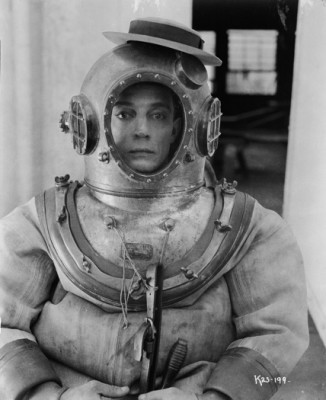
Please Note: The images used here are taken from stills and other promotional materials, not the Blu-ray edition under review.
It has an abandoned battleship, not a locomotive, as its perpetually in-motion, out-of-control set, but Buster Keaton's 1924 feature The Navigator -- the last occasion on which he shared directing credit before going full auteur for the following year's Seven Chances -- has much in common with his masterwork, The General, and not only plot-wise. It comes remarkably close to reaching the same heights, not only of comic/storytelling ingenuity, but of perfectly-honed mastery. Virtually every sequence is both brilliant on its own and an essential contributor to the whole, for an overall very well-unified film that's actually more than just the sum of its parts -- an endlessly fresh, self-renewing celluloid symphony that doesn't have a single unnecessary movement, or one that even comes close to lingering too long or wearing out its welcome. It's a tighter, better-controlled work than the equally delightful Seven Chances, and probably his best, most accomplished film until the deservedly exalted The General appeared three years later.
Keaton plays more or less the same spoiled, rich-young-man character he portrayed in Battling Butler and in his first feature, The Saphead, but The Navigator's character development actually sets up a bridge, traversed over the course of the film, from hapless indolence to equally hapless scrappiness, encompassing the two major personae Keaton would work with over much of his filmography. Rollo Treadway (Keaton) is bored, so bored that he wanders, ennui-ridden and fully clothed, into his sunken, luxury-suite bathtub. He decides to snap himself out of it by getting married; once all the arrangements and honeymoon plans have been made, he gets himself gussied up in a tuxedo, clutches a bouquet, and sets off to inform his sweetheart/the lucky girl, the equally young, rich, and naïve Betsy O'Brien (Kathryn McGuire, who also played Keaton's girl in Sherlock, Jr.) of her impending bridedom. (In one of the film's first sight gags, which is so simple and effective it's been reused all the way up through L.A. Story and Strangers with Candy, he situates himself comfortably in the backseat of his car as his chauffeur climbs in, and then is driven all the way...across the street, where his ostensible bride-to-be resides.) But for some reason incomprehensible to the entitled Treadway, Betsy doesn't take kindly to his so ostentatiously assuming an affirmative to the wedding plans he made entirely without her knowledge, and she sends him packing. Meanwhile, international spies from two unnamed "little countries" have been plotting to sabotage what they believe is an strategically important ship, the SS Navigator, which Betsy's magnate father happens to have just bought, out to sea. Treadway decides to evade his boredom by taking the bought-and-paid-for transpacific Honolulu "honeymoon" anyway, but mistakenly boards the very same Navigator due to be cut loose; Betsy -- who has accompanied her father to check up on his new purchase and is now racing toward his cries for help as he's accosted by the caught-in-the-act spies -- gets onboard, too, just in time to be stuck there as the ship drifts away from port and out into the unknown.
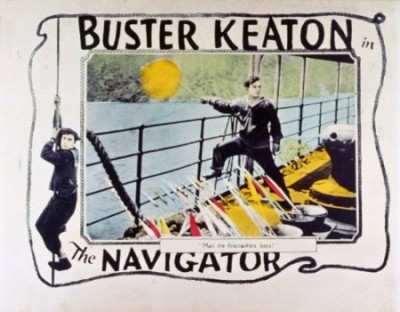
The two on-the-outs sweethearts don't realize anything about the reality or seriousness of their situation until the next day, when Treadway strides into a suspiciously empty dining room and seats himself expectantly, only to have it dawn on him veeery slowly that something's amiss. (The intuitive imaginativeness and exactitude in the mise-en-scène and framing of the clueless Keaton amid the obviously empty, abandoned space is just one example among many, but an especially subtle and elegant one, of the all-cylinders comedic sensibility constantly at work here.) He hears a noise from somewhere, alerting him to the fact that he's not alone, and his search for his fellow passenger leads to what is perhaps the greatest visual height in a film with no shortage of highs -- a pursuit around and around the ship's deck where we cut back and forth, port to starboard, as the increasingly frantic, now sprinting duo chases each other's tails, each one of them always missing the other just as he or she turns the corner out of sight. (The chase then tops itself, magnificently, with a cut to a very long shot from which we can see, as if in some ant farm, the two scrambling figures hectically seeking each other all over the ship, back and forth and top to bottom, before concluding with a pratfall that finally unites them.)
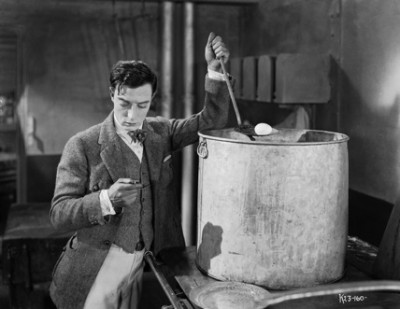
Several madcap vignettes wring copious, hilarious mishaps from the almost pitiable incapacity of the spoiled pair, now relying on each other as they attempt the most basic but unfamiliar tasks (broiling a piece of fish or brewing up some coffee, for two memorable, extravagantly screwed-up examples of chores Rollo and Mary are used to having done for them and now try, and very amusingly fail, to do for themselves). Cut to three weeks later, though, and the two, now cooperating (almost like a married couple, even), have mastered nautical life, albeit in their own eccentric fashion: they've decked out torpedo tubes as comfortable cabins and devised a number of astonishing Rube Goldberg contraptions to perform basic operations -- boiling an egg, opening a tin -- through ridiculously elaborate means. No sooner have they overcome that obstacle, though, than an island populated by hungry cannibals looms on the horizon, and the plucky couple's inexperienced incompetence overtakes them once again as they match wits with the "savages" (the default colonialist-minded, segregation-era racism here goes without saying and is bound to be duly noted by all contemporary viewers) while also saddled with a waterlogging gash in the ship's hull caused by Treadway's clumsy way with an anchor. After a centerpiece underwater sequence in which Treadway, who submerges for the first time in his life after diligently perusing the instruction manual for a deep-sea diving suit he and Betsy have come across, makes a hopeless attempt to fix the leak, the cannibals finally make their way on board, and it looks certain that Rollo and Mary are doomed to be eaten or drowned, unless there's some miraculous intervention from an unexpected direction....
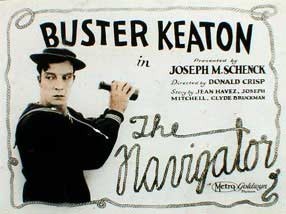
Vying with the on-deck chase sequence for most impressive cinematic playfulness is the brilliant (and green-tinted, no less) undersea sequence with Keaton, waddling around in his diving suit, fencing one swordfish with another and flailing about as he emerges from a black cloud of squid ink. Truth be told, though, the enthusiastic, nonstop exploitation of the visual properties of cinema for comic effect here becomes almost decadent, frequently elevating itself into the positively surreal; my favorite among many unpredictable, flawlessly choreographed jokes (which includes Mary using the diving-suited Rollo as a makeshift rowboat and the ignorant choice of a yellow "quarantine" flag to signal S.O.S. to an oncoming boat, which then hastily beats a retreat) was the framed portrait, hung prominently on the wall of Mary's cabin, of a very grouchy-looking sea captain ("played" by co-director and Broken Blossoms actor Donald Crisp), which creeps her out, preventing her sleep; she pushes it out the window, where that ominous, angry visage promptly swings, perfectly framed, into Rollo's porthole, scaring the bejesus out of the half-asleep young man, who now thinks he's the victim of a very grim and menacing ghost or peeping tom. These captivatingly inventive moments are not even always just for laughs: In a scene where a nearby phonograph is jostled into playing a most awkward lullaby for the insomniac duo (entitled "Asleep in the Deep"), the song's lyrics appear as onscreen titles within the gramophone's cabinet, making for something not unlike one of the ruefully sweet, tender, exuberant but half-melancholic touches out of Fejos's Lonesome. The most bravura, technically difficult, and elaborately choreographed shot is reserved for last, with a submarine interior caused, through yet another bit of Keaton clumsiness, to spin 360 degrees right before our eyes, like a washing machine containing the film's two lovebirds and some rather miffed-looking bystanders.
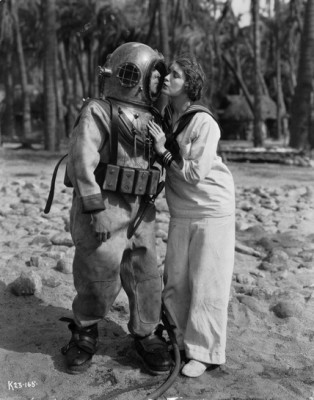
All the escalating, creative use of visual space in the film, which would be transfixing and inspiring regardless of viewing circumstances, is now topped off with the aforementioned restored color tinting, the icing on the cake of this treasurable, carefully and respectfully rendered new Blu-ray edition of the film. It's really too bad that many people over the years must have seen The Navigator in a hobbled, black and white version, since the gorgeous color coding of blue-for-nighttime, green-for-underwater, and that indelible yellow flag (recalling other, similarly galvanizing color-on-B&W effects, from the red flag in Battleship Potemkin to that cloud of pink smoke in Kurosawa's High and Low) are, if hardly unique in the oft-tinted annals of the silent age, particularly apt and purposefully deployed here. They do have a prettifying effect, and without a doubt enhance the film's beauty, but they're hardly just ornamental; they're part and parcel of its vision and actually make the experience much clearer, both visually and narratively. For all the fits-and-starts and elongation in the story's proceedings caused by the ineptitude of Rollo and Mary, that nothing-superfluous feel at the aesthetic level is impressively well-sustained throughout; there's a bounty of complications and long-simmering gags, but everything is streamlined, maximized -- nothing goes to waste. Like all of Keaton's best, The Navigator has a precision to its that's unmistakable; there's a most pleasing inevitability and symmetry to everything we see and to the film's story overall, as with a joke whose punch line resonates back to every detail of its buildup, or some machine running smoothly and transparently, letting us see and appreciate the exact necessity of every harmoniously dynamic part. But that's Buster Keaton for you: the laughs are endless, the charm abundant, the action often frantic, the love story unsentimental yet romantic, but there's a coolness there -- often contrasted to the warmth of his friend and fellow great filmmaker Charlie Chaplin -- that means not lack of feeling but a toning-down, a bit of distance from the emotion. Keaton's special gift allows us to enjoy the story, characters, and action while at the same time admiring the great beauty resulting from the director's rigorous marshaling of every specifically conceived, detailed shot, every sequence, and subsequently fitting them all together to create such clockwork flow, such well-balanced propulsion. The Navigator is exemplary of that particular genius Keaton had, almost the very best example from his entire output; if he hadn't somehow expanded even further upon it to give us The General, it would probably be this film, not the 1927 crown jewel, casting such a long, eternally enjoyable shadow over all subsequent movie history.
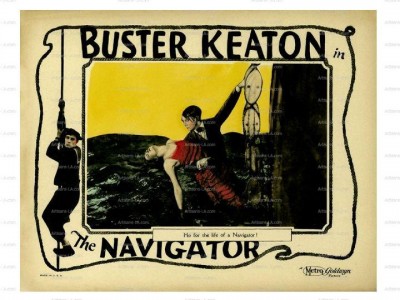
THE BLU-RAY DISC:
Presenting the film at its original aspect ratio of 1.33:1, this high-definition, AVC/MPEG4-1080p transfer, while not restoring the film to the pristine condition it's not been in since 1924, strikes a good balance between cleanup of wear and tear, and preservation of the film's celluloid textures, bringing The Navigator to us in very nice overall shape. Minor signs of age and wear -- scratches, flicker, etc. -- are visible throughout, but nothing so major as to distract from the film's excellence, with the restored color tinting well done and brought off to often ravishing effect. Considering the film's age and the decades of neglect that it (and all silents) suffered up until the relatively recent concerted, serious efforts to preserve such older films, it looks great.
Sound:The soundtrack, a well-considered facsimile of silent-era movie-house musical accompaniment composed and performed by Robert Israel, is available here as either uncompressed PCM 2.0 stereo or DTS-MA 5.1 surround. I chose the former for my viewing, as I find the really-big quality of surround sound not as fitting for the silent-film experience, but they both sound amazing, very clear and vivid, with the 5.1 being, of course, more room-filling and immersive if that's what you prefer.
Extras:--An 8-minute visual essay by film historian Bruce Lawton. Lawton draws on the clear depth and breadth of knowledge in his possession to share with us in his narration -- spoken over the relevant clips from the film and a large handful of stills -- the long-running recurrence of aquatic vessels in Keaton's work and a number of fascinating details about the making of The Navigator and the place it occupied, along with The General, closest to Keaton's heart out of all of his films.
--A relaxed, conversational, and informative audio commentary by silent film historians Robert Arkus and Yair Solan, whose back-and-forth expands upon some of the intriguing nuggets proffered by Lawton, with the two colleagues reminding each other (and us) of all the many other pictures many of the actors (even some of the minor ones) have also appeared in, the history of the Buford (the ship used as the main set in The Navigator), an ongoing film-scholarly debate about whether women in Keaton's films are actual characters or mere "props," etc. A nice contemplation and appreciation of the film that will broaden your frame of reference in a low-pressure, accessible way.
--An unusual and intriguing supplement appears in the form of audio from the original 78 rpm record (from 1913) of "Asleep in the Deep" performed by Wilfred Glenn, which, though not actually heard in the film, appears significantly as already mentioned, with the lyrics interpolated onscreen into the image. As the tune plays in this extra, it's accompanied by informational text and the relevant bit of the film.
--A gallery of stills.
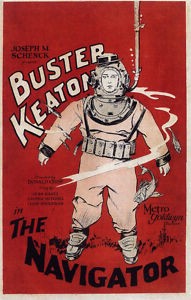
The last feature Buster Keaton would co-direct (nominally, at least; experts seem to concur that he's due credit for most of it), and a great artistic and commercial leap forward for the great, possibly very best silent-era comedian and filmmaker, The Navigator is an essential work for silent film aficionados, movie-lovers of all stripes, or anyone who just has a hankering for sheer, nonstop action-comic-romantic pleasure masterfully confected and served up with that singular, ingenious, deceptively nonchalant and imperturbable relish that belonged to Keaton alone. At 60 minutes, it's as compact and succinct as can be -- the shorter running time doesn't mean fewer brilliantly conceived/shot/edited gags, just a higher density of them -- but it's light and leisurely, too. However manic the onscreen action gets, the sublimely symmetrical, almost geometrical way in which it's all been framed/composed by the preternatural cinéaste behind the camera leads to that Keaton-trademarked laconic tone that makes the work feel so even-keeled and whole and provides, through the incongruous meeting of frenetic action and visual composure, some of the most helpless laughter the cinema's ever given us. Brought to Blu-ray by Kino in an excellent transfer that meticulously respects the film's original tinted color scheme, giving us the whole charming, captivating experience as close to the way Keaton intended it as we're ever likely to see, The Navigator is a flat-out classic, conscientiously restored and presented in tip-top shape, that's very Highly Recommended.
|
| Popular Reviews |
| Sponsored Links |
|
|
| Sponsored Links |
|
|
| Release List | Reviews | Shop | Newsletter | Forum | DVD Giveaways | Blu-Ray | Advertise |
|
Copyright 2024 DVDTalk.com All Rights Reserved. Legal Info, Privacy Policy, Terms of Use,
Manage Preferences,
Your Privacy Choices | |||||||













